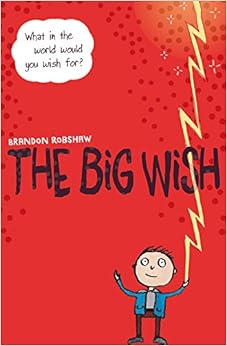 The author Brandon Robshaw, who has recently has his book The Big Wish published by Chicken House, writes here for us about his experiences of Writing for Children. Before you read his piece however a few words about his charming book. The book features Sam, a young boy who is given what many children may consider the best gift ever, unending wishes. The trouble is he soon learns that you really do have to be careful what you wish for and that perhaps this gift that keeps on giving is not really what he wanted...
The author Brandon Robshaw, who has recently has his book The Big Wish published by Chicken House, writes here for us about his experiences of Writing for Children. Before you read his piece however a few words about his charming book. The book features Sam, a young boy who is given what many children may consider the best gift ever, unending wishes. The trouble is he soon learns that you really do have to be careful what you wish for and that perhaps this gift that keeps on giving is not really what he wanted...
WRITING
FOR CHILDREN
Children hate being bored.
Everybody hates being bored, of course, but when we are young there is
something peculiarly painful and intolerable about it. I can remember as a
child being ready to scream with boredom on long car journeys, or in afternoon
lessons where time seemed to have stopped. And I didn't put up with boring
books. If a book was boring I threw it aside and found something else to do. On
the other hand, if the book was interesting it could put me into a trance. I
would lose myself in it completely.
If
you want to write for children, it's important not to forget this. An adult
reader might put up with a few boring pages, and be prepared to wait for the
good bits. But a child reader, justifiably enough, wants it all to be
good bits, starting from page one. This is even truer today than it once was,
for now there are far more rival attractions than there used to be. Kids can
spend their time playing Minecraft, or surfing the net, or going on social
media instead of reading books. So reading has to be fun, if it's going to
compete.
What
makes reading fun, then? I'd say there are four important things:
1)
The book
has to be written from the heart. If a writer thinks, ‘I know, I'll write a
book about superheroes because that's really popular with kids’, it's unlikely
that the book will be very interesting. But if the writer thinks, ‘I wonder
what it would be like to really have superpowers, that would be amazing!’, then
the book will come from the heart, and that will carry across to the reader.
2)
The
language. It has to be fresh and clear and bright. No waffling. Descriptions
should be vivid but short. Dialogue should be quick and punchy – no long
speeches – and it should sound natural. This doesn't mean the vocabulary has to
be simplistic. Children like learning new words, and they like silly, quirky,
made-up words, too.
3)
The pace.
It should be swift. Something happening on every page. Enough said.
4)
The
story. Children have a strong sense of wonder, and they like stories with
wonderful, crazy, unlikely or impossible events – as long as the author can
make those events feel real. ‘What if’ is one of the most powerful
engines to get a story going. What if my best friend turned out to be a spy?
What if I could go invisible? What if there was buried treasure under my house
and a gang of criminals found out about it? What if my dreams came true?
Whether the story is a realistic one or a fantasy, whether it's serious or
funny, children want to be able to satisfy that sense of wonder.
But the secret of writing a book
that children want to read isn't to tick off these four things one by one. It's
to get them all working together at the same time!
No comments:
Post a Comment